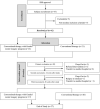Graded motor imagery training as a home exercise program for upper limb motor function in patients with chronic stroke: A randomized controlled trial
- PMID: 33546067
- PMCID: PMC7837923
- DOI: 10.1097/MD.0000000000024351
Graded motor imagery training as a home exercise program for upper limb motor function in patients with chronic stroke: A randomized controlled trial
Abstract
Purpose: Although several types of occupational therapy for motor recovery of the upper limb in patients with chronic stroke have been investigated, most treatments are performed in a hospital or clinic setting. We investigated the effect of graded motor imagery (GMI) training, as a home exercise program, on upper limb motor recovery and activities of daily living (ADL) in patients with stroke.
Methods: This prospective randomized controlled trial recruited 42 subjects with chronic stroke. The intervention group received instruction regarding the GMI program and performed it at home over 8 weeks (30 minutes a day). The primary outcome measure was the change in motor function between baseline and 8 weeks, assessed the Manual Function Test (MFT) and Fugl-Meyer Assessment (FMA). The secondary outcome measure was the change in ADL, assessed with the Modified Barthel Index (MBI).
Results: Of the 42 subjects, 37 completed the 8-week program (17 in the GMI group and 20 controls). All subjects showed significant improvements in the MFT, FMA, and MBI over time (P < .05). However, the improvements in the total scores for the MFT, FMA, and MBI did not differ between the GMI and control groups. The MFT arm motion score for the GMI group was significantly better than that of the controls (P < .05).
Conclusions: The GMI program may be useful for improving upper extremity function as an adjunct to conventional rehabilitation for patients with chronic stroke.
Copyright © 2021 the Author(s). Published by Wolters Kluwer Health, Inc.
Conflict of interest statement
The authors have no conflicts of interests to disclose.
Figures



References
Publication types
MeSH terms
Grants and funding
LinkOut - more resources
Full Text Sources
Other Literature Sources
Medical

